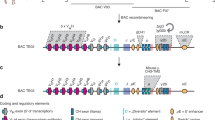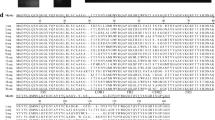Abstract
Genetic immunization is a simple, cost-effective, and powerful tool for inducing innate and adaptive immune responses to combat infectious diseases and difficult-to-treat illnesses. DNA immunization is increasingly used in the generation of monoclonal antibodies against targets for which pure proteins are unavailable or are difficult to express and purify (e.g., ion channels and receptors, transmembrane proteins, and emerging infectious pathogens). Genetic immunization has been successfully utilized in small inbred laboratory animals (mostly rodents); however, low immunogenicity of DNA/RNA injected into large mammals, including humans, is still a major challenge. Here, we provide a method for the genetic immunization of llamas, using a combination of biolistic transfection with a gene gun and intradermal injection with a DERMOJET® device, to elicit heavy-chain IgG responses against epidermal growth factor receptor (EGFR). We show the technique can be used to generate single-domain antibodies (VHHs) with nanomolar affinities to EGFR. We provide methods for gene gun bullet preparation, llama immunization, serology, phage-display library construction and panning, and VHH characterization.
Access this chapter
Tax calculation will be finalised at checkout
Purchases are for personal use only
Similar content being viewed by others
References
Lu RM, Hwang YC, Liu IJ et al (2020) Development of therapeutic antibodies for the treatment of diseases. J Biomed Sci 27:1
Eden T, Menzel S, Wesolowski J et al (2018) A cDNA immunization strategy to generate nanobodies against membrane proteins in native conformation. Front Immunol 8:1989
Hobernik D, Bros M (2018) DNA vaccines—how far from clinical use? Int J Mol Sci 19:3605
Liu S, Wang S, Lu S (2018) Using DNA immunization to elicit monoclonal antibodies in mice, rabbits, and humans. Hum Gene Ther 29:997–1003
Wolff JA, Malone RW, Williams P et al (1990) Direct gene transfer into mouse muscle in vivo. Science 247:1465–1468
Tang DC, DeVit M, Johnston SA (1992) Genetic immunization is a simple method for eliciting an immune response. Nature 356:152–154
Babiuk LA, Pontarollo R, Babiuk S et al (2003) Induction of immune responses by DNA vaccines in large animals. Vaccine 21:649–658
Kutzler MA, Weiner DB (2008) DNA vaccines: ready for prime time? Nat Rev Genet 9:776–788
Leitner WW, Ying H, Restifo NP (1999) DNA and RNA-based vaccines: principles, progress and prospects. Vaccine 18:765–777
Hamers-Casterman C, Atarhouch T, Muyldermans S et al (1993) Naturally occurring antibodies devoid of light chains. Nature 363:446–448
Muyldermans S (2001) Single domain camel antibodies: current status. J Biotechnol 74:277–302
Harmsen MM, De Haard HJ (2007) Properties, production, and applications of camelid single-domain antibody fragments. Appl Microbiol Biotechnol 77:13–22
de Marco A (2011) Biotechnological applications of recombinant single-domain antibody fragments. Microb Cell Fact 10:44
Bradbury AR, Sidhu S, Dubel S et al (2011) Beyond natural antibodies: the power of in vitro display technologies. Nat Biotechnol 29:245–254
Maussang D, Mujić-Delić A, Deschamps FJ et al (2013) Llama-derived single variable domains (nanobodies) directed against chemokine receptor CXCR7 reduce head and neck cancer cell growth in vivo. J Biol Chem 288:29562–29572
Peyrassol X, Laeremans T, Gouwy M et al (2016) Development by genetic immunization of monovalent antibodies (nanobodies) behaving as antagonists of the human chemR23 receptor. J Immunol 196:2893–2901
Koch-Nolte F, Reyelt J, Schössow B et al (2007) Single domain antibodies from llama effectively and specifically block T cell ecto-ADP-ribosyltransferase ART2.2 in vivo. FASEB J 21:3490–3498
Peyrassol X, Laeremans T, Lahura V et al (2018) Development by genetic immunization of monovalent antibodies against human vasoactive intestinal peptide receptor 1 (VPAC1), new innovative, and versatile tools to study VPAC1 receptor function. Front Endocrinol 9:153
Rossotti MA, Henry KA, van Faassen H et al (2019) Camelid single-domain antibodies raised by DNA immunization are potent inhibitors of EGFR signaling. Biochem J 476:39–50
Durocher Y, Perret S, Kamen A (2002) High-level and high throughput recombinant protein production by transient transfection of suspension-growing human 293-EBNA1 cells. Nucleic Acids Res 30:E9
Arbabi-Ghahroudi M, MacKenzie R, Tanha J (2009a) Selection of non-aggregating VH binders from synthetic VH phage-display libraries. Methods Mol Biol 525:187–216
Rossotti MA, Pirez M, Gonzalez-Techera A et al (2015) Method for sorting and pairwise selection of nanobodies for the development of highly sensitive sandwich immunoassays. Anal Chem 87:11970–11914
Arbabi-Ghahroudi M, Tanha J, MacKenzie R (2009b) Isolation of monoclonal antibody fragments from phage display libraries. Methods Mol Biol 502:341–364
Arbabi Ghahroudi M, Desmyter A, Wyns L et al (1997) Selection and identification of single domain antibody fragments from camel heavy-chain antibodies. FEBS Lett 414:521–526
Hussack G, Arbabi-Ghahroudi M, Mackenzie CR et al (2012) Isolation and characterization of Clostridium difficile toxin-specific single-domain antibodies. Methods Mol Biol 911:211–239
Baral TN, MacKenzie R, Arbabi Ghahroudi M (2013) Single-domain antibodies and their utility. Curr Protoc Immunol 103:Unit 2.17
Henry KA, van Faassen H, Harcus D et al (2019) Llama peripheral B-cell populations producing conventional and heavy chain-only IgG subtypes are phenotypically indistinguishable but immunogenetically distinct. Immunogenetics 71:307–320
Acknowledgments
This work was supported by the National Research Council Canada. We gratefully acknowledge the excellent assistance of Henk van Faassen, Shalini Raphael, Mary Foss, Hong Tong-Sevinc, Debbie Callaghan, and Sonia Leclerc.
Author information
Authors and Affiliations
Corresponding author
Editor information
Editors and Affiliations
Rights and permissions
Copyright information
© 2022 The Author(s), under exclusive license to Springer Science+Business Media, LLC, part of Springer Nature
About this protocol
Cite this protocol
Trempe, F., Rossotti, M.A., Maqbool, T., MacKenzie, C.R., Arbabi-Ghahroudi, M. (2022). Llama DNA Immunization and Isolation of Functional Single-Domain Antibody Binders. In: Hussack, G., Henry, K.A. (eds) Single-Domain Antibodies. Methods in Molecular Biology, vol 2446. Humana, New York, NY. https://doi.org/10.1007/978-1-0716-2075-5_3
Download citation
DOI: https://doi.org/10.1007/978-1-0716-2075-5_3
Published:
Publisher Name: Humana, New York, NY
Print ISBN: 978-1-0716-2074-8
Online ISBN: 978-1-0716-2075-5
eBook Packages: Springer Protocols




